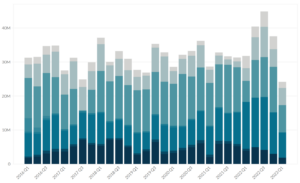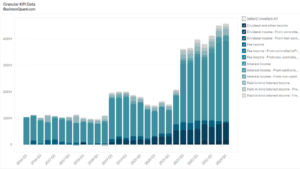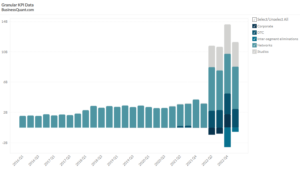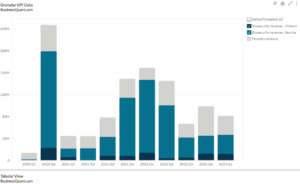
Clean Energy’s Revenue by Segment (2016-2023)
Exclusive Data
You need the Pro Plan to access KPI data
- Full access to the platform
- KPI data & segment financials on US stocks
- Financial data on thousands of stocks
- Download data in xlsx and csv formats
Pro Plan
$49 per month*
60% discount ends in:
.
About
More information
Subscribe to Pro or Enterprise plans to unlock this feature.
Contact the Analyst
Subscribe to Pro or Enterprise plans to unlock this feature.
Become a smarter investor today.
Access KPIs & Segment Financials on US stocks
This statistic highlights Clean Energy’s Revenue by Segment, split between AFTC, Station construction sales, Volume-related, and other segments, reported on a quarterly basis from Q1 2016 onwards.
Clean Energy’s Revenue by Segment
| Segments | Q3 2020 | Q3 2019 | YoY Growth | Revenue share in Q3 2020 |
| AFTC | $5 | 0 | – | 7% |
| Other | 0 | $0.1 | -100% | 0% |
| Station construction sales | $8.8 | $6.4 | 38% | 12% |
| Volume-related | $57.1 | $67.9 | -16% | 81% |
| Total | $70.9 | $74.4 | -5% | 100% |
(All figures in millions, except percentages)
Clean Energy’s revenue mostly consists of volume-related revenue, station construction sales, and AFTC revenue. Its revenue is dependent on factors like the amount and timing of vehicle fuel sales, station construction sales, and recognition of government credits, incentives, and grants, like AFTC, the natural gas commodity prices, and sales of Environmental Credits.
AFTC
Under the United States federal legislation, Clean Energy is eligible to receive a federal alternative fuel tax credit (AFTC) against its natural gas vehicle fuel sales made from 2016 onwards. The AFTC is equal to $0.50 per diesel gallon of LNG and $0.50 per gasoline gallon equivalent to CNG. Either the company or the customer can claim the credit, based on the service relationship with the customer.
AFTC is a variable factor since it can increase or decrease the transaction price based on the volumes of vehicle fuel sold. Without the authorization of federal legislation, AFTC revenue is not recognized. It is recognized in the period the credit is authorized through federal legislation.
In Q3 2020, Clean Energy collected $5.0 million through AFTC. Revenue from AFTC accounted for 7% of the company’s total revenue.
Station construction sales
It is always considered beneficial to build your own station depending upon the fuel needs. Clean Energy offers complete station integration services to design, construct, and commission fueling stations and facilities. For more than 20 years it has fabricated, built, engineered, and maintained natural gas fueling stations across North America. It has built public stations as well as private stations providing all forms of RNG like liquified (LNG), compressed (CNG), or a combination of the two (LCNG).
Liquified (LNG)
Like gasoline and diesel fuel, renewable natural gas is delivered via trailer by LNG stations. RNG has a fuel time similar to diesel in its liquified form. Over the past two decades, Clean Energy Cryogenics has constructed approximately 70% of LNG stations in the United States.
Compressed (CNG)
The way gas is drawn into homes for residential use, the same way CNG stations receive renewable natural gas from a local utility pipeline. The RNG is then compressed on-site and distributed as fuel directly into the vehicles. There are two types of CNG fueling stations available, the first is the fast-fill and the second is time-fill, which is a slower process ideal for overnight fueling.
Combination of the two (LCNG)
The dual-purpose fueling station option is used when there is insufficient natural gas or electrical power. In this system, to deliver both CNG & LNG fueling capabilities incorporates the base components of an LNG station with additional CNG components.
As of Q3 2020, Clean Energy generated 12% of total revenue amounting to $8.8 million from this segment. There has been a 38% increase in revenue from this segment from $6.4 million in Q3 2019. This increase in revenue is primarily due to increased construction activities.
Volume-related
Clean Energy’s volume-related revenue comprises CNG, RNG, LNG fuel, sales of RINs and LCFS Credits, and the performance of O&M services in addition to changes in the fair value of its derivative instruments. Derivative instruments consist of commodity swap and customer contracts associated with Company’s Zero Now truck financing program. As of Q3 2020, Clean Energy generated 81% of total revenue amounting to $57.1 million from this segment. However, there has been a 16% decrease in revenue from this segment from $67.9 million in Q3 2019.
Company Overview
Clean Energy Fuels Corp. is an American-based company established in 1997 by T. Boone Pickens and Andrew J. Littlefair. Clean Energy’s headquarters is in Newport Beach in California. Clean Energy Fuels Corp. completed its initial public offering in 2007 on the NASDAQ Global Select Market under the trading symbol “CLNE”.
It is the largest provider of vehicular natural gas (CNG and LNG) having a broad customer base in the refuse, shuttle, intrastate, interstate trucking, transit, taxi, and airport and municipal fleet markets with tens of thousands of vehicles fueling at important locations in the United States and Canada. Its customers are Phoenix Sky Harbor International Airport, Waste Management, SYSCO Foods, Denver International Airport, Los Angeles International Airport, SuperShuttle, Foothill Transit, Dallas-Ft. Worth International Airport, Ft. Worth Transportation Agency, Denver RTD, MTDB of San Diego, and the US Navy. Some of its competitors are Shaanxi Heimao Coking, SPT Energy Group, MODEC, and Basic Energy Services.
Did you like Clean Energy’s Revenue by Segment statistic?
Access thousands of more such key performance indicator data points, on listed companies, with Business Quant.
You can also get started for free.
More data on US Stocks

Our Plans
Always know what you’ll pay. No hidden costs or surprises.
- Annual
- Monthly
60% discount till April 30
Pro
For serious investing
-
Company KPI data Access segment financials, non-GAAP metrics and KPI data from presentations and filings. Examples include financials by segment / region / product category, AT&T's broadband subscriber trends, Tesla's deliveries by model and lots more.
-
Stock research tools Features include : stock screener, stock comparison, industry financials, stock warnings, advanced charting tools, timeseries tables, scatter charts, financial statements, stock reports, SEC filings, stock ratings, institutional and insider ownership data. There are 200+ financial items and ratios on thousands of US stocks.
-
Industry data & tools Access premium operating data on 40+ industries. Examples include market share, smartphone shipments by vendor, subscribers by wireless carrier, historical gold production. There are 20,000+ such statistics.
Enterprise
For tailored workflows
-
All of Pro plan Get unfettered access to all our dashboards and dossiers.
-
Custom built features Get tailored dashboards built specially for you , based on your set of requirements, to simplify your research workflow.
-
Admin billing Back-end documentation support and multi-seat licensing.
* Billed annually, local taxes extra.
60% discount on Annual plan
Pro
For serious investing
-
Company KPI data Access segment financials, non-GAAP metrics and KPI data from presentations and filings. Examples include financials by segment / region / product category, AT&T's broadband subscriber trends, Tesla's deliveries by model and lots more.
-
Stock research tools Features include : stock screener, stock comparison, industry financials, stock warnings, advanced charting tools, timeseries tables, scatter charts, financial statements, stock reports, SEC filings, stock ratings, institutional and insider ownership data. There are 200+ financial items and ratios on thousands of US stocks.
-
Industry data & tools Access premium operating data on 40+ industries. Examples include market share, smartphone shipments by vendor, subscribers by wireless carrier, historical gold production. There are 20,000+ such statistics.
Enterprise
For tailored workflows
-
All of Pro plan Get unfettered access to all our features.
-
Custom built features Get tailored dashboards built specially for you , based on your set of requirements, to simplify your research workflow.
-
Admin billing Back-end documentation support and multi-seat licensing.
* Local taxes extra.






